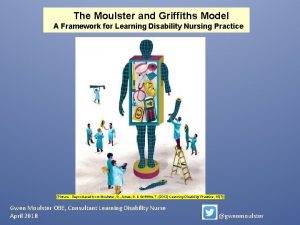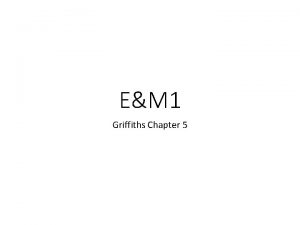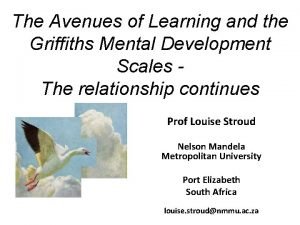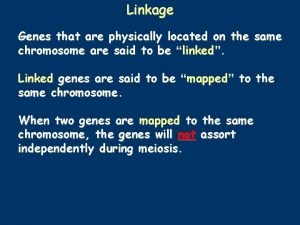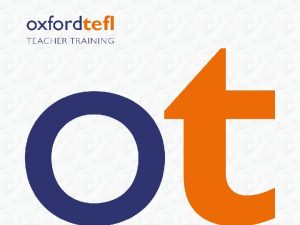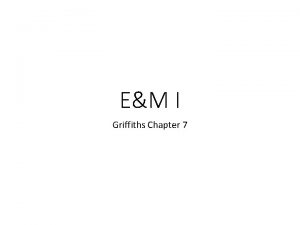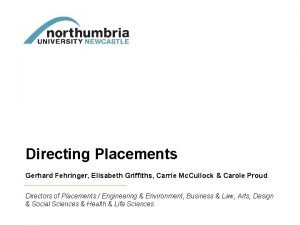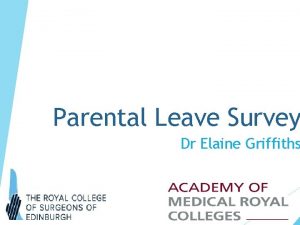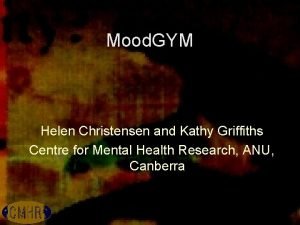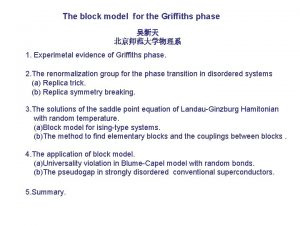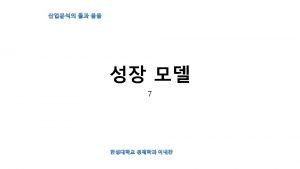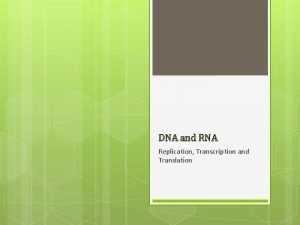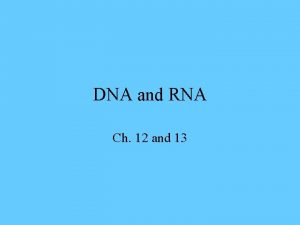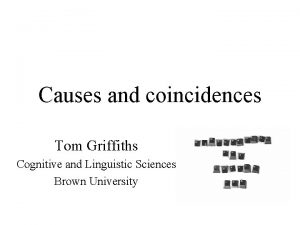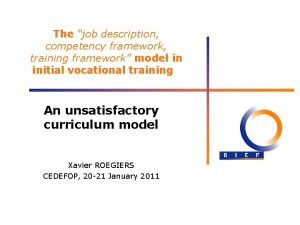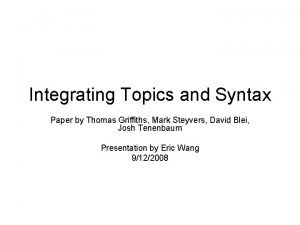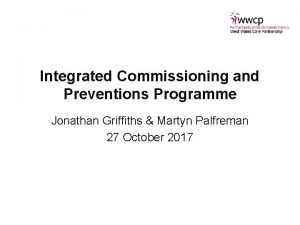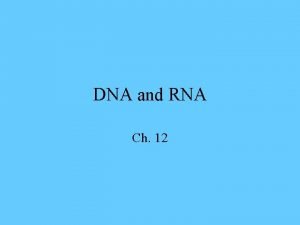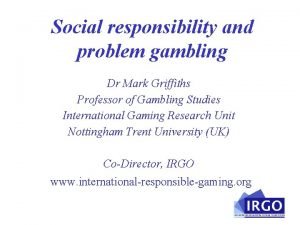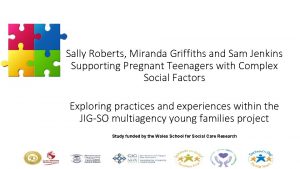The Moulster and Griffiths Model A Framework for
































- Slides: 32

The Moulster and Griffiths Model A Framework for Learning Disability Nursing Practice (Picture - Reproduced from Moulster, G. , Ames, S. & Griffiths, T. (2012) Learning Disability Practice, 15(7)) Gwen Moulster OBE, Consultant Learning Disability Nurse April 2018 @gwenmoulster

Learning Disabilities Nursing: What’s happening now? National shortage of learning disability nurses ‘Facing the Facts, Shaping the Future’ (Public Health England, 2017) On-going difficulties in recruiting students to learning disability nurse training programmes (Council of Deans of Health, 2017) This includes a 55% reduction in Consultant Nurse Posts, Data from NHS Digital shows 46% reduction in learning disability nurse leadership. 44% reduction in Modern Matron Posts and 45% reduction in Nurse Manager Posts in learning disability services from March 2010 to March 2018.

• • What’s happening now? • • Increased media attention enhanced by Social Media in relation to inquiries, scandals and poor practice Introduction of Nurse Associate and apprenticeship roles Changing needs of people with learning disabilities and their families Increasing learning disabled population and complexity of needs requiring more intensive and highly skilled interventions • Learning disability nurses are unique, they are an essential, highly skilled resource for improving health outcomes for people who have learning disabilities.

People who have learning disabilities and their families value what we do

Why use a nursing model/framework? • Nursing models help nurses achieve uniformity and seamless care and support nurses in assessing, planning, and implementing care by providing a working framework • Aggleton & Chalmers (2000) suggest that all nursing models have seven key characteristics. These focus on the person, problems creating a nursing need, assessment, planning and goal setting, nursing implementation and evaluation of quality and outcomes. • Nursing models have been described as ‘conceptual tools or devices that can be used…to understand place complex phenomena into perspective’ (Mc. Kenna 1997)

Why use a nursing model/framework? • There is a clear relationship between the use of models of care and the achievement of outcomes for those supported (Kaplow and Reed, 2008). • There is a relationship between professional nursing practice, improved patient outcomes and a reduced mortality rate. Kaplow and Reed (2008) • The use of a person-centred model when supporting someone with a learning disability, improved outcomes for them. Parley (2001) • Where there may be a lack of role clarity, use of a conceptual model acts as a means of highlighting what is important to and for the professional group (Curley, 2004).

The Moulster and Griffiths model • The aim of the model is to ensure that all nurses, regardless of their place of work understand what the basis of their nursing practice is (Moulster, Ames and Griffiths, 2012). • It ensures a shared vision for learning disability nursing practice that can be explored and explained to the people we support, and those we are accountable to. By using the model, learning disability nurses will ensure that all people, regardless of locality, receive the same standard of person-centred and evidence-based nursing care (Ames, 2013). • The model has clear benefits to the nurses using it, as it allows them to work in a systematic way that encourages reflective practice. It also ensures that their experience and intuition is recognised and utilised to ensure a personcentred outcome for the individual (Moulster, Ames and Griffiths, 2012).

The Moulster & Griffiths Model • The model takes a variety of influences which are established and is therefore based on sound evidence based practice: • • • Aldridge’s (2004) Ecology of health model Gibbs (1988) Reflective model Mc. Cormack and Mc. Cance’s (2006) Person centred framework Orem’s (2001) Self care model The Nursing Process (Atkinson & Murray 1990) • The framework supports a structured bio-social-spiritual-emotional assessment, essential for effective comprehensive nursing interventions

Moulster & Griffiths Framework for Learning Disabilities Nursing Evaluate Outcomefocused Person-centred Assess Evidence based Plan Implement Reflective Eclectic model bringing in ideas and evidence from other models and frameworks

Moulster and Griffiths Model for Learning Disability Nursing Practice (Updated April 2018 & adapted from Aldridge 2004) Impact of nursing Emotions and wellbeing The Person's: * Relationships * Social contact * Mental health * Employment and meaningful activities * Leisure activities * The treatment and care provided by the nurse and his or her: * Personality * Knowledge * Skills * Attitude * Ability to reflect and respond Communication and behaviour How to communicate effectively with the person and how he or she: * Expresses contentment, discomfort, pain, happiness and unhappiness * Communicates particularly about his or health & wellbeing * Impact of personal behaviours on self and others Lifestyle Knowledge and Understanding The person's: * Ability to learn * Mental Capacity * Understanding of rights Physical Health Whether health action plans, care and emergency plans are in place and the person: * Receives health support * Has had illnesses, or is at risk of illness * Is on long term medication * Has regular review of health status and needs Person-centred care The effect of person-centred plans on the person's health and wellbeing and their: * Personal aspirations * Dreams and wishes *Plans for the future * Support structure and care * Environment and home * Reasonable adjustments * Special needs * Culture * Nutrition and exercise * Additional marginalizing factors * Safety History * What has affected, is affecting, or could affect the person's health and his or her: * Life with family and carers * Safeguarding issues * Education * Important people, places, events, * Previous experiences

Using the Nursing Process

Undertaking the assessment • • Although we work multi-professionally our nursing assessment is important It highlights the person’s nursing needs and informs the care plan The assessment tool in the Moulster and Griffiths framework is based on the evidence base for effective nursing assessment, a combination of other nursing assessment tools (all anon) and the knowledge, experience and ideas brought by the authors in consultation with LD nurses from the Haringey team in London. It has recently been updated an Excel version is now available

Using evidence • The modern learning disability nurse should be working within the context of current thinking and policy, to help ensure the care given is consistent and of the highest quality. • Learning disability nurses should apply nursing skills and knowledge in a structured way that is person-centred and based on the best evidence available (Royal College of Nursing 2011; DH 2007; NMC 2007) • Northway et al (2006) advocate nurses contributing to research and improving evidence-bases for care


Measuring outcomes • Difficult to measure specific nursing outcomes • The development of the Health Equalities Framework (HEF) has given nurses a tool that enables assessment of outcomes regardless of the environment the nurse is working in.

Introducing Dave • Dave is 54, he has moderate learning disabilities and is on the autistic spectrum • Dave moved into a residential home in the community ten years ago after his father died • Dave’s Mum and brother are in regular contact • About a year ago Dave had surgery for a bladder problem and was fitted with an indwelling catheter • Since then he has regularly suffered with infections requiring a course of antibiotic treatment

Introducing Dave • Dave often finds personal care difficult and can be verbally abusive and on occasions has also hit out at staff caring for him • This has resulted in Dave being prescribed antipsychotic medication as well as extra sedation whenever he needs the catheter changing • Recently the Consultant Psychiatrist, (Elle) and a community learning disability nurse, (Janet) have been working with the staff in the home to try to reduce the antipsychotic medication • They had a theory that changes in Dave’s behaviour might be because of pain caused by infection

Introducing Dave • The home manager did not seem to understand that pain or illness might be at the heart of Dave’s problems and did not want the medication to be changed. • Recently Dave became very unsettled and challenging especially when receiving personal care, this resulted in an emergency psychiatric visit. • Two doctors from mental health services who had no experience of learning disabilities assessed him. The home manager said she believed he was mentally unwell and described his complex behaviours, this resulted in section papers being completed for him to be admitted to a mental health in patient service. • Luckily for Dave there was nowhere suitable for him to go, so he stayed in his home that night

Introducing Dave • The following morning the specialist learning disability service was contacted and asked to organise for Dave to be admitted to a mental health unit. • Alison the community matron from the Intensive Support Team (IST) and Elle agreed to go to see him and Janet was advised of the situation. • Alison spoke to staff and to Dave’s mum and brother • Alison and Janet completed a HEF profile • Janet organised an emergency meeting with the GP and the social worker and Elle contacted mental health colleagues for an update

Using the Moulster and Griffiths model as a framework for nursing Dave • Janet completed a person centred screen and identified person centred goals with Dave and his family. Even though it was an emergency situation this was still important. Dave wanted to: • Enjoy time at home with his family • Go out with friends for a picnic • Go on holiday • To be pain free • To choose his support staff and the people who help him • To choose when to get up and when to have personal care

Dave’s initial HEF profile

Initial plan • An emergency care plan was put in place to assess Dave’s pain levels, treat him for infection and work closely with him and his family to establish the best way to support him • Alison and Janet created a pain picture, life book, health action plan and hospital passport with him • The GP started him on a pain patch containing morphine • Alison, Elle and Janet worked closely with the care provider to identify the help and support they needed to enable him to stay at home • The home manager was changed and with the support of the specialist health learning disabilities service a different approach to his care was implemented

Using the Moulster and Griffiths model as a framework for nursing Dave • Following the introduction of the emergency plan, Alison and Janet reflected on all the information they had gathered through the person centred screen, the M & G nursing assessment and the HEF profile • Janet developed a full nursing care plan and easy read care plan using pictures of people and objects of reference that Dave could identify with. • As well as the person centred goals, Janet some desired health outcomes. • Janet used evidence to inform the best nursing interventions. In particular, she drew on evidence related to working with people on the autism spectrum, effective communication, pain assessment and management, partnership and multiagency working, health action planning and the use of hospital passports. • References and evidence were included in the professional care plan to inform anyone providing the nursing care.

Following interventions • Dave is much happier now • Dave has started going out and socialising and his relationship with his family has improved significantly • Dave’s care staff are working with him in a different way and his behaviour has really changed. There have been no recent incidents of physical aggression • Dave is still living in his home and is settled and content • Dave’s HEF profile shows a significant reduction of the impact of the health inequalities previously putting Dave at significant risk of serious illness.

Dave’s follow up HEF profile

Janet’s evaluation Janet reviewed Dave’s care plan, reflecting on Dave’s person centred outcomes and health outcomes. Using the Moulster and Griffiths model helped Janet to formulate an effective person centred, evidence based care plan. Janet had confidence in the approaches she used because they were based on evidence and the things that mattered to Dave. Janet used her reflection within her personal supervision to discuss effective and less effective nursing approaches and any professional development needs. Janet was able to use the reflection of her personal contribution to Dave’s care as a reflective study for her NMC revalidation.

Thank you • To all the learning disabilities nurses in Haringey for their help, support and engagement in the inital development and implementation of the Moulster & Griffiths Framework • In particular to: • Tom Griffiths for helping in the development of the model/framework in the early stages and for his involvement in writing the articles • Sarah Ames for her involvement in writing the articles • Crispin Hebron and colleagues from 2 gether Trust in Gloucestershire for their work on reasonable adjustments • Barnet community nursing team for their work on easy read care planning

Thank you • Jane Iorizzo and Sarah Ames for their help in updating the Moulster & Griffiths model in 2013 • Joshua Kernohan for his help in the 2017 update • Nurses from SSSFT NHS Trust, student nurses from Wolverhampton and Keele Universities and people with learning disabilities and their families and advocates, for their involvement in the conferences that produced the graphics used in this presentation • Pen Mendonca for Graphic facilitation and artwork • To all those involved in creating the book on the model “The Moulster and Griffiths Nursing Model: a framework for learning disability nursing practice” to be published early 2019 https: //www. amazon. co. uk/Moulster-Griffiths. Nursing-Model-Disability/dp/178592480 X N. B. In the case study ‘Dave’ used in this presentation, all names, pictures and identifying details have been changed to ensure confidentiality.

References & useful reading Aggleton, P. & Chalmers, H. (2000) Nursing Models and Nursing Practice (2 nd edition), Basingstoke: Macmillan Aldridge, J. (2004) ‘Learning disability nursing: a model for practice’ in Turnbull, J. (ed) Learning disability nursing. London, Blackwell Science Ltd, pp. 169 -187 Atkinson L. D & Murray M. E. (1990) Understanding the nursing process: Fundamentals of care planning BBC television (2011) Undercover care: The Abuse Exposed: Panorama Television programme. British Broadcasting Corporation. First broadcast 31 May 2011. Council of Deans of Health, (2017) Learning disability nursing meeting report https: //councilofdeans. org. uk/wp-content/uploads/2017/11/reportfrom-the-learning-disability-roundtable. pdf (Accessed 27 th March 2018) Gibbs et al (1988), cited in Bulman, C. and Schutz, S. (eds) Reflective Practice in Nursing. 4 th edition. Oxford: John Wiley & Sons Ltd. p. 225 DH (2006), Modernizing Nursing Careers Department of Health (2007) Good Practice in Learning Disability Nursing. London: Department of Healthcare Commission (2007 a) A life like no other: a national audit of specialist inpatient healthcare services for people with learning difficulties in England. London: Commission for Healthcare Audit and Inspection Healthcare Commission (2007 b) Investigation into the service for people with learning disabilities provided by Sutton and Merton Primary Care Trust. London: Commission for Healthcare Audit and Inspection. Mc. Cormack, B. and Mc. Cance, TV. (2006) ‘Development of a framework for person-centred nursing’, Journal of Advanced Nursing, 56(5), pp. 472 -479.

References & useful reading Mc. Kenna 1997 Mc. Kenna, HP. (1997), Nursing theories and models. Oxon: Routeledge, p. 12. Mencap (2007) Death by Indifference. Following up the Treat me right! report. London: Mencap (2012) Death by Indifference 74 deaths and counting Michaels J (2008) Healthcare for All NHS Digital (2017) Health and Care of People with Learning Disabilities: Experimental Statistics: 2016 to 2017 https: //digital. nhs. uk/catalogue/PUB 30167 (Accessed 27 th March 2018) Northway, R. & UK Learning Disability Consultant Nurse Network (2006) Shaping the Future: A Vision for Learning Disability Nursing. UK Learning Disability Consultant Nurse Network, United Kingdom Nursing and Midwifery Council (2007) The code: Standards of conduct, performance and ethics for nurses and midwives. [Online] Available at: www. nmc. -uk. org/nurses-and-midwives/the-code-in-full (Accessed 27 th March 2018) Nursing and Midwifery Council (2010) Pre-registration nursing education in the UK. [Online] Available at: http: //standards. nmcuk. org/Pre. Reg. Nursing/non-statutory/Pages/overview. aspx (Accessed 27 th March 2018) Orem, D (2001) Nursing: concepts of practice. 6 th ed (First published 1991). London: Mosby. Public Health England (2017) Facing the Facts, Shaping the Future

References & useful reading Lemos & Crane 2012 Loneliness and Cruelty: People with learning disabilities and their experience of harassment, abuse and related crime in the community Parliamentary and Health Service Ombudsman (2009) Six Lives: the provision of public services to people with a learning disability. London: The Stationary Office. Robertson, J. , Emerson, E. , Hatton, C. , Elliott, J. , Mc. Intosh, B. , Swift, P. , Krinjen-Kemp, E. , Towers, C. , Romeo, R. , Knapp, M. , Sanderson, H. , Routledge, M. , Oakes, P. , and Joyce, T. (2005). The Impact of Person Centred Planning. Institute for Health Research, Lancaster University Royal College of Nursing (2009) Reflective practice. [Online] Available at: https: //www. rcn. org. uk/professional-development/revalidation/reflection-andreflective-discussion (Accessed 27 th March 2018). Royal College of Nursing (2011). Learning from the past – setting out the future: Developing learning disability nursing in the United Kingdom. London: Royal College of Nursing. Sanderson, H. , Thompson, J. , Kilbane, J. (2006) ‘The Emergence of Person. Centred Planning as Evidence-Based Practice’, Journal of Integrated Care, 14(2) pp. 18 -25. Scottish Government, (2012) Strengthening the commitment. The report of the UK Modernising Learning Disabilities Nursing Review UK Consultant Nurse Forum (2006) A Vision For Learning Disability Nursing DH (2009) Valuing People Now: Rights, independence, choice, inclusion, personalisation

Developing a person centred, reflective, evidence based and outcomes focused model/framework for learning disability nursing Gwen Moulster OBE
 Moulster and griffiths model
Moulster and griffiths model Ampere's law solenoid
Ampere's law solenoid Griffiths mental development scales
Griffiths mental development scales Griffiths 2015
Griffiths 2015 Multipole expansion of magnetic vector potential
Multipole expansion of magnetic vector potential 10 examples of sentence stress
10 examples of sentence stress Electrodynamics
Electrodynamics Bbsms
Bbsms Elisabeth griffiths
Elisabeth griffiths Commutation relation in quantum mechanics
Commutation relation in quantum mechanics Griffiths
Griffiths Elaine griffiths
Elaine griffiths Mood gym club
Mood gym club Griffiths valuation map
Griffiths valuation map Theoretical and conceptual framework
Theoretical and conceptual framework Fspos
Fspos Typiska novell drag
Typiska novell drag Nationell inriktning för artificiell intelligens
Nationell inriktning för artificiell intelligens Returpilarna
Returpilarna Varför kallas perioden 1918-1939 för mellankrigstiden?
Varför kallas perioden 1918-1939 för mellankrigstiden? En lathund för arbete med kontinuitetshantering
En lathund för arbete med kontinuitetshantering Personalliggare bygg undantag
Personalliggare bygg undantag Personlig tidbok för yrkesförare
Personlig tidbok för yrkesförare Sura för anatom
Sura för anatom Förklara densitet för barn
Förklara densitet för barn Datorkunskap för nybörjare
Datorkunskap för nybörjare Boverket ka
Boverket ka Mall debattartikel
Mall debattartikel Delegerande ledarstil
Delegerande ledarstil Nyckelkompetenser för livslångt lärande
Nyckelkompetenser för livslångt lärande Påbyggnader för flakfordon
Påbyggnader för flakfordon Tryck formel
Tryck formel Svenskt ramverk för digital samverkan
Svenskt ramverk för digital samverkan
